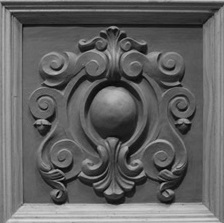Location: Watertown, Wisconsin, USA
The drinking fountain located at the intersection of Main and Washington Streets was commissioned by the benevolent industrialist Robert E. Lewis and his wife Fanny in memory of their son, Clifton, who died age 44 from Bright’s disease, an inflammation of the kidneys.

Circa 1902. Used with permission. Source: http://www.watertownhistory.org/Articles/LewisFountain.htm
Erected in 1896, the fountain was manufactured by J. L. Mott Iron Works of New York. The structure was seated on an octagonal stone plinth. It consisted of a single pedestal with attic base and canted corners surmounted by a bronze statue of an Indian Chief.

Circa 1898.Used with permission. Source: http://www.watertownhistory.org/Articles/LewisFountain.htm
The fountain supplied water to horses, humans and dogs via dolphin mascarons. Eight arched cornices contained dolphin masks which are symbolic of guardians of water. Two of the mascarons spouted water into demi-lune fluted basins for human consumption. Drinking cups were suspended by chains.
Horses drank from two large demi-lune fluted troughs from which overflow water fed four smaller basins on each corner for the refreshment of smaller animals. A plaque between the dog troughs was inscribed with the maker’s name, The J.L. Mott/Iron Wks. N.Y.
An attic base supported a short column containing 4 inset panels bounded by pilasters. Within the panels, 3 cartouches contained bas-relief and a fourth cartouche was an engraved plaque.
The addition of a second concrete plinth raised the height of the horse troughs in 1908. Consoles bearing globe lamps were attached circa 1919.

Circa 1919. Used with permission. Source: http://www.watertownhistory.org/Articles/LewisFountain.htm
The capital supported the Indian figure. The statue of an Indian was originally a wood carving created by Samuel Anderson Robb who was the leading cigar store Indian peddler. It was carved for William Demuth & Co. who cast it in zinc and advertised it in his catalog as “No. 53 Indian Chief.” In 1873, the J.L. Mott Iron Works purchased the design and listed it in their catalog of statuary. In his right hand the Indian Chief holds an arrow, and in his left hand he holds a bow attached to a base near his left foot, which rests on a rock. (This stance is called contrapposto, where one leg bears the weight and the other leg is relaxed.) A tree stump behind his right leg balances the sculpture. He is dressed in a headband containing three feathers, a bear claw necklace, a cloak, a breechcloth (fabric tucked into a belt that covered the front and back), fringed leggings and moccasins.



The fountain was removed in 1908 to lay street car rails, and upon completion, it was re-erected in an east/west direction to lessen the chance of an accident while horses were drinking.

Circa 1908. Used with permission. Source: http://www.watertownhistory.org/Articles/LewisFountain.htm
However, the fountain became an obstacle with the advent of the motor vehicle, and in 1925 the statue was toppled when a car hit the structure. Damaged beyond repair, a duplicate purchased from J. L. Mott Iron Works was erected in Union Park. It deteriorated there over several decades due to inclement weather and vandalism until it was relocated to the grounds of the Octagon House Museum in 1964 where it is in the custody of the Watertown Historical Society.

Used with permission. Source: http://www.watertownhistory.org/Articles/LewisFountain.htm
Many thanks to the Watertown Historical Society for permission to use the images. For a more in depth history please visit their site at http://www.watertownhistory.org/Articles/LewisFountain.htm
Glossary
- Attic base, a column base with two rings
- Canted corner, an angled surface which cuts of a corner
- Cartouche, a structure or figure, often in the shape of an oval shield or oblong scroll, used as an architectural or graphic ornament or to bear a design or inscription.
- Console, a decorative bracket support element
- Contrapposto, stance where one leg bears the weight and the other leg is relaxed
- Demi-lune, half moon or crescent shape
- Mascaron, a decorative element in the form of a sculpted face or head of a human being or an animal
- Pedestal, an architectural support for a column or statue
- Pilaster, a column form that is only ornamental and not supporting a structure
- Plinth, flat base usually projecting, upon which a pedestal, wall or column rests.

